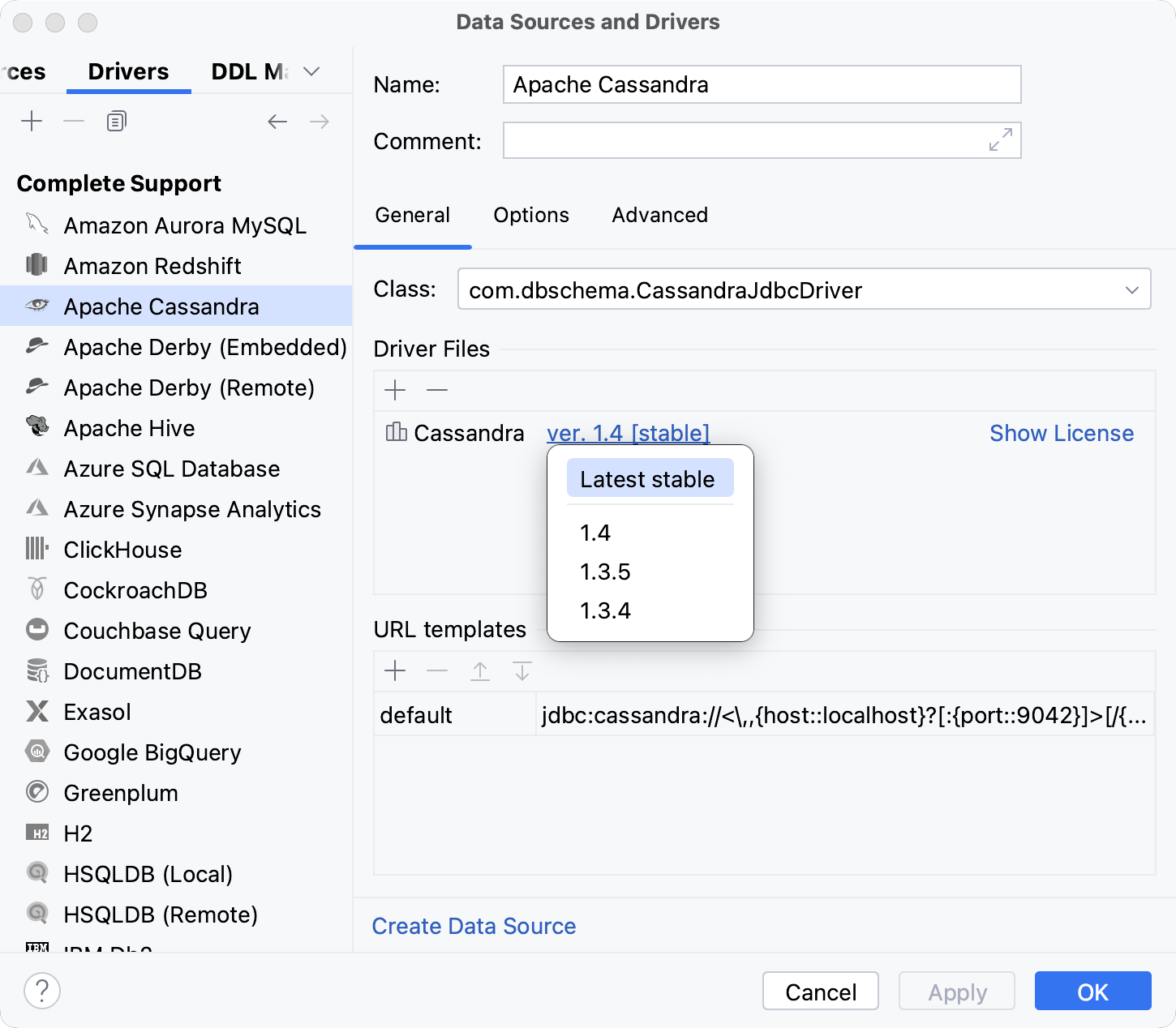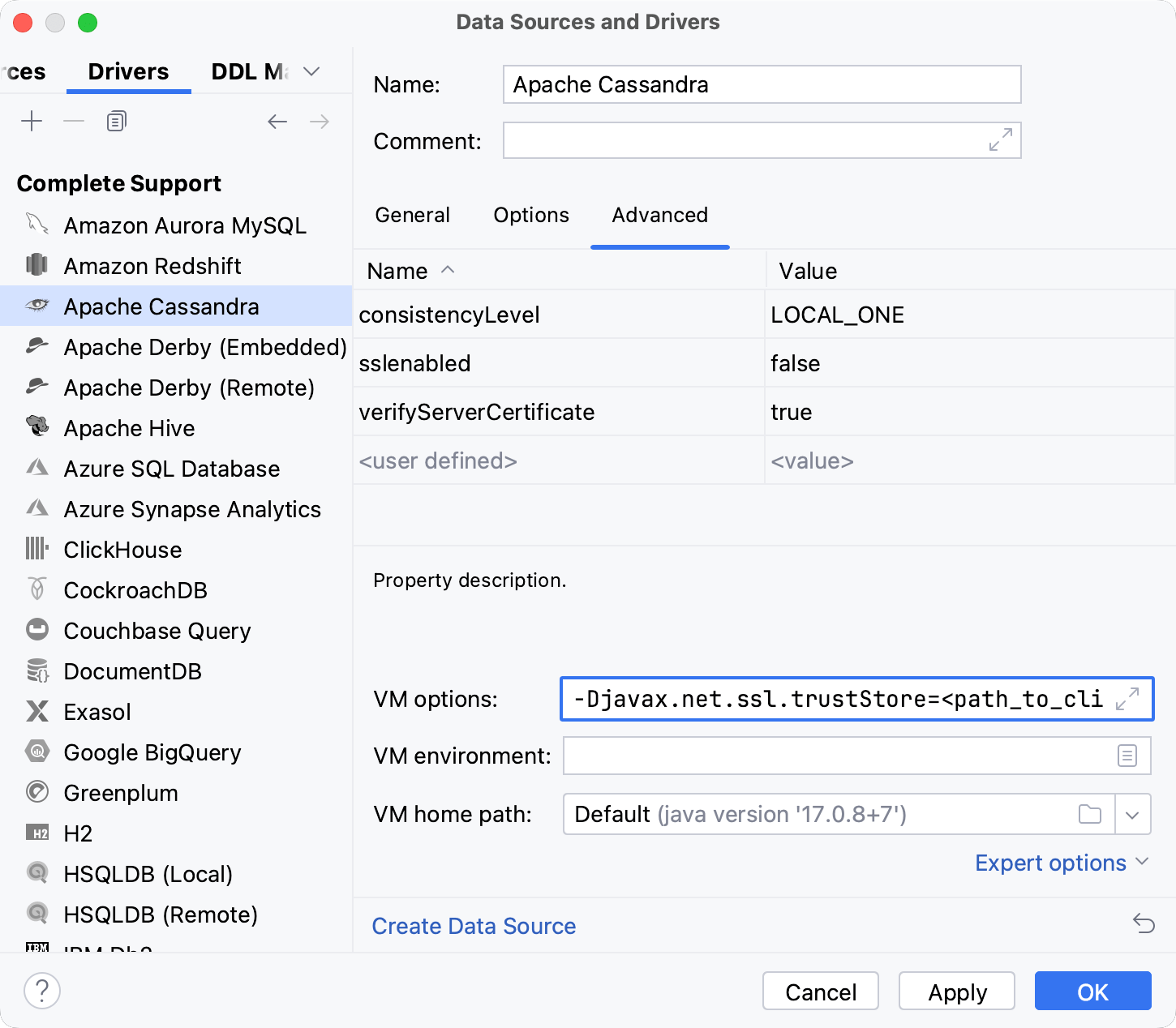Create an Apache Cassandra data source with SSL
Enable the Database Tools and SQL plugin
This functionality relies on the Database Tools and SQL plugin, which is bundled and enabled in JetBrains Rider by default. If the relevant features are not available, make sure that you did not disable the plugin.
Press Ctrl+Alt+S to open settings and then select .
Open the Installed tab, find the Database Tools and SQL plugin, and select the checkbox next to the plugin name.
Step 1. Create a Apache Cassandra data source
To connect to a database, create a data source that will store your connection details.
In the Database tool window, click
New and select Connect to Database.
If you have a connection string for the database defined in your solution or elsewhere, leave the Use connection string option selected and choose Apache Cassandra in the Database type selector.
Use the String selector to choose the desired connection string from your solution or type it in manually, then click Connect.
You can also choose Add data source manually, click Next and select Apache Cassandra in the Database source selector. Follow the wizard steps to form the connection string by configuring individual options.
To access all available options for the new database connection, click
in the Database window, then click
New and select Apache Cassandra.
Check if there is a Download missing driver files link at the bottom of the connection settings area. Click this link to download drivers that are required to interact with a database. For a direct download link, refer to the JetBrains JDBC drivers page.

Location for the downloaded JDBC drivers is the JetBrains Rider configuration directory.
You can also use your drivers for the database instead of the provided ones. For more information about connecting to a database with your driver, refer to Add a user driver to an existing connection.
If there is no Download missing driver files link, then you already have the required drivers.
In Host, Keyspace, User, Password, and Port fields, specify connection details.
Step 2. Verify the version of the JDBC driver
Verify that you use the JDBC driver of version 1.3, or later.
Open data source properties by doing one of the following:
On the Database tool window toolbar, click
Data Sources.
Press Shift+Enter.

In the Drivers tab, select Apache Cassandra.
In the Driver files pane, click ver. <version_number> and select
Latestor1.3.

Step 3. Set VM options
Open data source properties by doing one of the following:
On the Database tool window toolbar, click
Data Sources.
Press Shift+Enter.

In the Drivers tab, select Apache Cassandra.
In the driver settings, click the Advanced tab.
In the VM options field, specify options for authentication.
Server authentication: your client verifies that the server is correct and trusted. The truststore must contain a public key of the server or the CA certificate that was used to sign the server key.
-Djavax.net.ssl.trustStore=<path_to_client_truststore> -Djavax.net.ssl.trustStorePassword=<truststore_password>Client authentication: the server verifies the client that tries to connect to the server.
-Djavax.net.ssl.keyStore=<path_to_client_keystore> -Djavax.net.ssl.keyStorePassword=<keystore_password>

Step 4. Add the sslenabled option to the JDBC URL
Add the
sslenabled=trueoption to the JDBC URL. For example, jdbc:cassandra://localhost:9042/?sslenabled=true.Ensure that the database connection can be established using the provided details. To do this, click the Test Connection link at the bottom of the connection details section.

If you encounter any connection issues, refer to the Cannot connect to a database page.
(Optional) By default, only the default keyspace is introspected and available to work with. If you also want to work with other keyspaces, in the Schemas tab, select them for the introspection.

Click OK to create the data source.
Find your new data source in the Database tool window.
For more information about the Database tool window, see the corresponding reference topic.
For more information about working with database objects in JetBrains Rider, refer to Database objects.
To write and run queries, open the default query console by clicking the data source and pressing F4.
To view and edit data of a database object, open Data editor and viewer by double-clicking the object.
